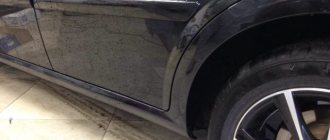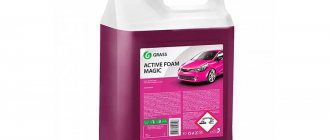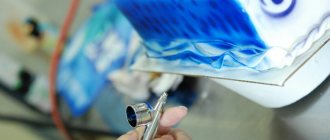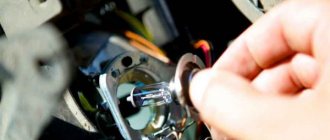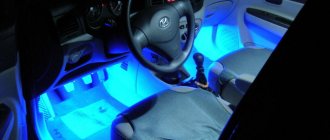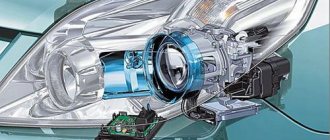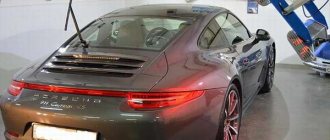The most common type of lamps for automotive optics has been halogen headlights for more than 30 years. Lighting is installed both on the main lights and on the side lights and fog lights.
Instead of a vacuum, there are halogens in the flask, where the main place is occupied by volatile compounds of bromine and iodine. When the tungsten filament is heated, bromine settles on the glowing element, preventing the metal from becoming thinner, while the walls of the lamp always remain transparent.
Best H7 Halogen Bulbs
This category contains the best car halogens from reliable manufacturers who have earned their reputation for high performance characteristics. Increased brightness, high power or expensive housing parts - which h7 halogen lamp is better? To choose a suitable lighting device for your car that will meet all the assigned tasks, you need to study the main parameters of the nominees and choose the best one.
Bosch Pure Light 1987301012 H7 12V 55W
An excellent choice for motorists who want to get optimal German quality at the most affordable price. The model has an even light distribution in the forward direction, although the luminous flux is a little weak. Powered by 12 V, suitable for almost all brands of cars.
Advantages
- Maximum versatility;
- Uniform distribution of the light beam along the road and side of the road;
- Low cost.
Flaws
- Does not tolerate increased voltage;
- Short service life.
The Bosch Pure Light halogen bulb is a good replacement for a standard car bulb; the low-range mode deserves special praise. Has a pleasant white light.
The best batteries for a car
Koito H7 Whitebeam 4200K 12V 55W P0755W
According to the Japanese manufacturer, this sample lamp is twice as bright as similar products from competitors. Reviews from car owners also confirm this characteristic. The lamps shine with bright white, expensive light. Power 100 W, color temperature reaches 4200 K, while the heating temperature does not exceed the norm.
Advantages
- Well-focused light output;
- Good performance in extreme conditions;
- Soft white light;
- High water resistance.
Flaws
- Short service life;
- High price.
The main advantage is the high-strength refractory glass flasks that filter UV radiation. According to driver reviews, the model provides an even low beam with a soft white tint that does not dazzle oncoming vehicles.
General Electric H7 12V- 55W (PX26d), 35017 (58520U)
An excellent choice for low and high beam fog lights. The lamp features an improved filament modification and gas composition, which allows it to emit light with greater efficiency at a temperature of 3250 K and a power of 55 W. In terms of indicators, the color is closer to daytime white, which allows you to get a wide viewing angle at night.
Advantages
- Good viewing angle;
- Improved reflection from road markings;
- Does not blind oncoming cars;
- Average price.
Flaws
Inconvenient plastic packaging.
Lighting devices are protected from ultraviolet radiation, this parameter is especially important when used in plastic headlights, which significantly reduces the risk of their clouding.
Osram Night Breaker Laser H7 64210NL 12V 55W
German H7 white halogen lamps are significantly ahead of the competition in the fight for durability. Naturally, the increased brightness slightly reduced the resource, but the 300 hours of guaranteed service life is impressive. The unique technology made it possible to create an improved filament, balancing the main performance characteristics.
Advantages
- Brighter than competitors by +50%;
- Large viewing angle;
- Excellent focusing in the dark;
- Tempered flasks with UV protection.
Flaws
High price.
If you are thinking about which H7 base lamp to buy for low and high beam headlights, we recommend paying attention to the Osram Night Breaker Laser H7 model. It has high luminous efficiency due to the improved composition of the gas bulb, pumped under high pressure with the addition of xenon
MTF Aurum HAU1207 H7 12V 55W
South Korean gas-discharge halogen with a special coating, enhanced color temperature of 3000 K. Halogen lamps for cars h7 MTF Aurum emit a pleasant golden light, which provides better contrast in the perception of the illuminated route in rain, snow, and fog.
Advantages
- Optimal beam focusing in the dark;
- Good viewing angle;
- Bright golden light;
- Does not blind oncoming cars;
- Low price.
Flaws
Not detected.
Installing halogen lenses
In cases where standard head optics do not provide high-quality road illumination, it is recommended to install additional halogen light sources. To do this, you will need headlights, a block and fuses, wires, a power button, a power relay, heat-shrink tubing, electrical tape, clamp blocks, as well as a set of screwdrivers and wrenches.
First you need to decide on the choice of additional headlights. The best option may be standard devices for which there are mounts in the bumper of your model. If this is not provided by the manufacturer, you can buy any halogen headlights if you have the appropriate certificates. It is better to buy optics complete with wiring and fuses. For standard low beam lamps with a power of 55 W, 10 A fuses and 25-30 A relays are sufficient.
Remember, the optimal connection diagram for halogen headlights is through the low beam relay contact or to the ignition switch. In this case, when the ignition is turned off, the additional headlights will turn off automatically.
This way, you can avoid draining the battery if, for some reason , you suddenly forgot to turn off the headlights forcibly. Additional headlights must be connected via a relay with fuses.
All work on installing additional optics should be done by first disconnecting one of the battery terminals. All wires and connectors must be carefully insulated, and relays and contact buttons must be placed in heat-shrinkable tubes.
Halogen headlights are installed in standard spots on the bumper, if any. If such places are not provided, then the optics should be mounted in accordance with the requirements of the Technical Regulations. After installing the headlights, we install the wiring. One of the headlight wires should be connected to ground in any convenient place by screwing it to the body. The remaining two wires are placed in a corrugated plastic tube and attached to the car's standard wiring with plastic clamps. Then the wires are brought into the interior. Try to arrange the wiring in the area where the relay and fuse panels are located.
Rating of the best halogen lamps
There are a large number of different halogen designs, including modified versions with increased light output, increased service life or xenon light effect. Let's look at the best examples of lamps in all categories below.
Standard
The most popular today are standard classic halogen lamps. The best of them can be called:
- Philips Vision +30% - German-made samples emit a directional white light flux with a temperature of 3200K. Almost identical to factory elements. Resistant to vibration and shaking. They differ in their affordable cost of about 300 rubles. The disadvantages include a blurred light border.
- Philips Vision Plus +60% is an improved, more powerful version of the previous lamps. The actual power is only 49 W, against the declared 55. They light the road well. They increase the lighting area in front of the vehicle by 25 meters, thanks to a 60% increase in brightness. The disadvantages include the relatively high price of 700-800 rubles, as well as sensitivity to high voltage.
Osram Original Standard is a reliable and inexpensive option, costing about 200 rubles. They produce bright light with a temperature of 3200K. The disadvantages of this specimen include its short service life.
MTF light Standard +30% is a Korean-made single-filament version with increased light output by 30% and a temperature of 2900K. It features an improved thread that significantly extends its service life and durable glass that perfectly absorbs ultraviolet radiation. Mtf lamps are resistant to low temperatures and cost about 300-350 rubles.
With increased brightness
If desired, you can purchase auto lamps with a stronger luminous flux, the best examples among them are:
Philips X-Treme Vision +130% is the brightest lamp model available today. Emits the most powerful white light flux (+ 130% brightness) with a temperature of 3700K. The advantages of the model include high-quality assembly, reliability and a long service life of 450 hours. The only drawback is the high cost of about 1200 rubles.
Osram Night Breaker Unlimited + 110% - reliable lamps with 110% increased brightness and white light (3400K) from a German manufacturer. They have an acceptable cost of 1,500 rubles per pair. The disadvantages of the model include not the longest service life and the possibility of slight blinding of oncoming traffic.
MTF light ARGENTUM +80% is a budget option with the highest brightness, with a power of 55W and a white color of 4000K. They produce 80% more light than standard halogen models, illuminating the path 15 m further. Made from special durable glass, they cost 800-900 rubles. No significant shortcomings were identified in the model.
KOITO Whitebeam is a Japanese model with increased brightness, almost twice as bright as its competitors. It has a color temperature of 4200K, which is closest to natural daylight, but visibility is noticeably lost in rain. It is distinguished by a blue flask. You can buy a pair of koito for 2000 rubles.
With extended service life
If you don’t want to constantly replace lamps, you can pay attention to samples with an extended service life:
Philips LongLife EcoVision - characterized by a 4-fold increased service life - 3 years or 100,000 km. They give out a yellowish tint (3100K), which not many people like. They cost around 550 - 700 rubles.
Osram Ultra Life - service life is the same as Philips, 3 years (or 2000 hours). It has a temperature of 3200K and a brightness of 1550 lm at a cost of 600 - 800 rubles. However, the lamp, as a rule, does not reach its three-year lifespan.
With xenon light effect
Below you can find the best low beam lamps with xenon effect:
Philips Crystal Vision - halogen samples with a xenon effect, emit a pleasant light with a temperature of 4300K with a bluish tint. They are not very bright, cost on average about 1300 rubles. for a couple.
MTF Light Palladium - model with a crystal blue tint, 5500K. It features a two-layer coating and special glass that absorbs most of the ultraviolet radiation. Absolutely safe for the plastic of headlights, but can blind oncoming motorists. The most budget option with xenon effect. A set of 2 pieces can be purchased for 850 rubles.
OSRAM Cool Blue Intense - distinguished by a white-blue glow color of 4200K, closest to real xenon. They produce 20% more brightness - 1500 lm. They will cost the buyer 1000 rubles per pair. One of the disadvantages is insufficient lighting in the rain.
Osram COOL BLUE INTENSE H4 64193CBI-HCB 12V 60/55W
Next in our TOP are Osram COOL BLUE INTENSE lamps. Although their name refers to the presence of a cold blue glow, in practice the light turns out to be bright white with a slight yellow tint, corresponding to a color temperature of 4200 K. It is not entirely clear why the manufacturer came up with such a name, but it is worth noting that the light of such lamps is as close as possible to to natural daylight, which makes it pleasant to the eye and does not cause fatigue, unlike standard lamps. It is also worth noting that compared to standard halogen lamps, OSRAM COOL BLUE INTENSE is 20% brighter. In dry weather, the high beam illuminates the road and the side of the road very brightly and far away. True, the service life of such lamps will be shorter compared to conventional halogen lamps. With intensive use, for example, in a taxi, they last for 2-3 months. But most car owners will be able to stretch out the pleasure of using such headlights for six months or even a year. In general, if you want your car's headlights to glow with a bright white light that is pleasing to the eyes, then I recommend purchasing Osram COOL BLUE INTENSE.
- Power: 60/55 W.
- Voltage: 12 V.
- Luminous flux: 1650/1000 Lm.
- Color temperature: 4200 K.
- Min. service life: 50/200 h.
- Base: P43t.
- Dimensions: 82 x 17 x 17 mm.
Types of diode lamps for cars
LED matrices are extremely popular today, since they help to significantly reduce the cost of the finished structure. And the cost is reduced due to the fact that several diodes are combined into one crystal. Thus, production becomes cheaper and at the same time the quality and characteristics of the finished lamp increase.
The type of design of ice lamps is determined by the use of a certain type of matrix, it may be.
- Regular matrix. It contains exclusively the usual blue diodes. And the lens is coated with phosphor - a special substance that converts the original blue color into the desired shades of white and yellow.
- RGB matrix. It already houses different types of diodes, namely red, green and blue. It is precisely each letter of the abbreviation that implies an abbreviation for the color of the LEDs in English: Red, Green and, accordingly, Blue. The bottom line is that mixing colors determines the tone of white or yellow in the output. But the shades of the resulting white are regulated by decreasing or increasing the intensity of the glow of a particular color in the matrix. In this case, it is possible to obtain a wider spectrum of white, but less energy efficiency is observed. With aging, the color may become somewhat distorted, since the wear of different colors of diodes will occur unevenly.
But the diodes themselves can be manufactured using technologies such as:
SMD - this technology is the most popular at present; it means that the diodes are fixed to the surface of the lamp. Features easy installation and low energy consumption
In this category, special attention should be paid to powerful LEDs, which, when consuming 10 W or more, have a very bright glow and do not require additional diffuse lenses; COB - using this technology, diodes are installed on the board itself. Thus, the volume is reduced, greater uniformity of the luminous flux is ensured and cooling is improved.
Advantages
Suitable for standard headlight units. Halogen emitters are the most common among all types of lamps, so most standard lighting equipment designs are designed specifically for such elements. However, it must be taken into account that we are talking about lamps with standard energy consumption. Powerful models (up to 130 W) produce an enhanced light beam, but at the same time generate many times more stray heat, which can melt the reflector and burn out its own standard wiring. To install such lighting elements, the headlights require modification.
They have a wide range of design options. Modern car light manufacturers produce both standard models of halogen emitters and modified samples:
- With increased wear resistance
- With increased light beam
- With increased power
- With reduced glare
- Suitable for all weather conditions
Increasing the area of clear vision at a distance of several tens of meters will be useful for all categories. Because of this, it is difficult to recommend specific types of tuned lamps to certain categories of road users.
Which car lamps to buy
When choosing certain lamps, it is necessary to take into account their power (as a rule, this value is standard and is 55 W), the value of the luminous flux, the temperature of the light and the type of base.
If a lamp (or one of its modes) in one headlight fails, it is advisable to buy a pair of new ones and replace them simultaneously in both headlights. This will ensure they have the same glow and approximately the same service life. You will also find information about the type of base in the documentation for the machine. Let's take a closer look at color temperature and flux.
Color temperature and luminous flux
When choosing lamps, it is also worth considering their color temperature. After all, it directly depends on the type and power of the light bulbs. For the human eye, the most optimal color temperature is in the range of 4000. 6500 Kelvin. This range corresponds to white daylight emitted by artificial or natural sources. For example, a cool white fluorescent lamp emits light with a temperature of 4000 K. And midday white light has a temperature of 6500 K.
However, the lamps mentioned above are not always appropriate. If there is poor visibility or fog outside, it is better to use bulbs with a lower temperature (for example, 3000 K and below). For reference: a 200 W incandescent lamp emits light with a temperature of 3000 K. Based on this, the best option would be the following choice:
- for fog lights it is better to choose light sources with a temperature in the range of 3000. 3500 K;
- for conventional headlights, it is better to buy lamps with a temperature of 4000 K and above.
When purchasing a lamp, pay attention to the luminous flux value. In accordance with the current state standard GOST R 41.37-99 (UNECE Rules No. 37), for lamp types h7 it should be 1350 lumens for 6-volt lamps, and 1550 lumens for 12-volt lamps
This requirement is due to compliance with safety requirements for both the driver of the direct vehicle and the drivers of oncoming cars.
Don't buy too powerful lamps! The rated power value is indicated in the vehicle documentation. Otherwise (if the light bulb is very powerful), there is a risk of damage to the reflector due to its constant overheating. And this means replacing the entire headlight, which naturally won’t be cheap.
Manufacturers
Currently, there are a large number of brands and manufacturers on the market. Not taking into account little-known Chinese and other brands, the most common are the following: OSRAM, Philips, BOSCH, Narva, Mayak. The choice between them should be made based on standard indicators - the presence of the desired light bulb model in their line, the warranty period, the originality of the product, the price-quality ratio.
Employees of the reputable publishing house “Behind the Wheel” conducted real tests of lamps from the manufacturers mentioned above. The tests were carried out on a Chevrolet Aveo car with headlights that had been in use for one and a half years. The luminous flux value was measured using the Ecolight-02 device separately for the right and left headlights. The test results are summarized in a table. The letter "L" means left headlight, and "P" means right headlight.
| Manufacturers | Distance and luminous flux value | |||||||||||||
| 10 | 20 | 30 | 40 | 50 | 60 | 70 | ||||||||
| L | P | L | P | L | P | L | P | L | P | L | P | L | P | |
| OSRAM | 134 | 188 | 17,7 | 42,4 | 5,25 | 14,5 | 2,24 | 8,08 | 1,11 | 5,05 | 0,33 | 3,05 | — | 1,8 |
| "Lighthouse" | 127 | 173 | 23,6 | 38,3 | 6,14 | 16 | 2,56 | 9,05 | 1,27 | 6,06 | 0,64 | 3,6 | 0,3 | 2,35 |
| Philips (+30%) | 110 | 188 | 12,4 | 33,3 | 3,59 | 13,6 | 1,23 | 7,64 | 0,54 | 4,84 | — | 2,8 | — | 1,57 |
| BOSCH | 94,3 | 152 | 14,8 | 34,4 | 3,13 | 13,1 | 1,25 | 6,37 | 0,65 | 3,89 | — | 2,3 | — | 1,35 |
| Narva | 91,5 | 177 | 9,34 | 30,7 | 2,24 | 10,3 | 0,7 | 4,81 | — | 2,83 | — | 1,27 | — | 0,46 |
| Standard lamps | 78,3 | 102 | 9,03 | 21,3 | 2,05 | 7,03 | 0,32 | 3,6 | — | 1,73 | — | 0,69 | — | 0,17 |
| LED | 64,3 | 89,6 | 17,7 | 24,9 | 8,65 | 10,4 | 4,98 | 4,01 | 3,14 | 3,86 | 2,17 | 2,58 | 1,6 | 1,78 |
The table also shows values for light-emitting diode (LED) lamps that have been inserted into headlights designed for standard halogen lamps. As can be seen from the tests performed and the results presented, their luminous flux indicators are extremely low. Therefore, we repeat the above information that LED lamps can only be used with appropriate headlights!
Philips X-tremeUltinon LED gen2 11342XUWX2 H4
Philips X-tremeUltinon LED gen2 LED lamps complete our TOP. With a bright white, high-intensity beam, these LED bulbs take headlights to the next level, allowing you to see further and improving visibility by up to 250%. Such bright illumination is achieved through the use of unique premium LED chips, which provide daylight-like illumination even at night. In addition, excellent illumination is also achieved thanks to the ideal shape of the light beam. This means that the beam illuminates the necessary sections of the road without blinding other drivers, which increases the safety of travel at night. And increased visibility not only improves the safety of night driving, but also makes it more comfortable. These lamps emit bright white light with a color temperature of 5800 K, providing a daylight effect. Modern cars are equipped with lamps with this color temperature, since it has been proven that it is most comfortable for the human eye and recognition of warning signs. Improved visibility allows you to notice obstacles in time and choose the optimal trajectory. And since you no longer have to look at what's happening ahead, driving will become even more comfortable. Other advantages of these lamps include protection against dust and splashes corresponding to the IP65 standard and a long service life of up to 5000 hours.
- Voltage: 13.2 V.
- Power: 22 W.
- Luminous flux: 700/1100 Lm.
- Service life: up to 5000 hours.
- Color. temperature: up to 5800 K.
- Base: P43t.
What are the penalties?
Installation of LED lamps is punishable by a fine, and in some cases drivers face deprivation of their license.
Reason for deprivation of rights
For the unintended installation of LED headlights, drivers may be deprived of their license for a period of 6 to 12 months on the basis of paragraph 3 of Article 12.5 of the Code of Administrative Offenses of the Russian Federation. But in practice, this measure is not always applied legally correctly. The law prescribes this punishment for the owners of those cars in which both the color glow of the headlights and their operating mode are impaired: flashing instead of constant.
If you follow the interpretation of the article of the law, then you cannot deprive your license for white, yellow or orange LED lamps in the headlights. The operating mode of the LED light bulb is also questionable. They “blink” only when there is a malfunction. However, in practice, everything is much more complicated, and the court deals with such issues.
Checking the correct installation of lamps
The essence of such a roadside check is to verify the markings of the headlights and the lamps installed in them. The inspector will not dismantle the lighting fixtures right on the road, but he may ask you to open the hood and draw up a report if the required names do not match.
When purchasing a used car, you should check the installed headlights. The previous owner could replace the standard lighting, but the new owner would have to pay the fine.
What is the penalty for installing LED lamps?
According to paragraph 1 of Article 12.5 of the Administrative Code, the fine for improperly installed LED lamps is 500 rubles. The driver is given a warning about the malfunction, and he is obliged to eliminate it.
Legal change of headlights
The installation of LED headlights on a car whose design does not provide for them can be legalized by the traffic police. It is necessary to confirm compliance of the changes made with the standards assigned by GOST and traffic rules. The driver must undergo a safety check of his vehicle. The expert institution will have to provide a large number of certificates and documents for LED headlights.
Xenon or LEDs: which lamps to choose
Now let's look at what is better, xenon bulbs or LEDs. Even if we discard all legal restrictions, if it is necessary to improve car lighting by replacing the standard halogen, the question arises, which is better, a xenon lamp or diode bulbs
So, it is important to understand that every decision has both pros and cons.
Xenon lamps are capable of shining brightly and illuminate the road well. In this case, you should select the correct lamps according to the “temperature”. In short, 4300K xenon produces a more yellow glow, 5000K is closer to a blue-white light, while, for example, 6000K has a bluish-white glow.
So, the latest 6000K version illuminates a dry road well, but the light is “lost” in the rain, on wet asphalt, etc. In turn, xenon 4300K is optimal for rain, snow or fog, but on dry asphalt it may seem that it does not shine so brightly. It turns out that the best xenon lamp will be a high-quality 5000K option.
It is also important to understand that if xenon is installed in a headlight instead of halogen, and without modifications, such headlights will inevitably dazzle drivers of other vehicles. It is noteworthy that adjustments do not completely solve the problem.
For this reason, it is recommended to install lenses in the headlights. Of course, costs increase, since the headlight will need to be disassembled and modified.
With LEDs, things are also not so simple. First, the LED headlight has a special design. If you install such a lamp in halogen optics, the choice of solutions is limited and the price is higher. However, even if you can find such light bulbs, they are relatively easy to install, but the problems are not solved.
It is still recommended to modify the headlight. Since the LED lamp is bright, the situation resembles regular xenon without lenses in standard halogen optics. Glass with a reflective pattern refracts the light flux, causing stray light, which can lead to blinding of oncoming drivers.
As for LED lenses, such solutions exist, but the cost is quite high, and the quality of light compared to lensed xenon is questionable. The reason is the peculiarities of the LED light bulb itself, which illuminates the lens on the sides. If you remake the optics for lenses, it is easier to install a bilens and xenon.
In any case, to answer the question of what affects the quality of headlight light, you must consider the following:
- condition of the headlight and optics adjustment;
- type of lamp (halogen, xenon, LED lamps);
- characteristics of the headlight bulb itself (power, glow temperature);
- quality of finishing (presence or absence of a lens in the headlight), polishing of the optics, painting of the reflector, etc.
- correct installation of lighting equipment, etc.
Advantages and disadvantages of halogen lamps
Let's look at the advantages and disadvantages of halogen lamps. Positive characteristics include:
- Low cost;
- High shelf life and service life;
- Availability of lighting elements of different glow temperatures.
The negative side is that a halogen lamp is initially, after all, an incandescent lamp. They differ in that they consume a lot of energy. Also, halogen lamps require special installation: they should not be touched with hands (they may darken). This makes the installation process difficult.
Line laying
Daiwa and Shimano match reels are distinguished by high-quality line winding. This is one of the most important indicators of the quality of the presented products. Match fishing involves performing long casts. If the thread on the bobbin is wound unevenly, with overlap, this operation will become almost impossible. This will be especially noticeable when using a light float.
When choosing a reel, you need to check how the line fits on the spool. If unevenness and other defects are visible, this tackle should be put aside. It will bring a lot of problems during the fishing process. In order not to spoil your vacation, you should purchase quality products.
It is recommended that the reel screw for match fishing be endless. This design improves the quality of thread winding. The service life of this type of gear is higher than that of other varieties. An endless screw is not a requirement. The main thing is that the product is of high quality.
How to choose h7 LED lamp
- Study the declared characteristics of the model you like, especially the size compliance with the car brand.
- Determine the presence and authenticity of the quality certificate. Products that have passed the necessary tests last longer than non-certified models.
- Functional properties should not contradict current safety indicators (GOST R 51709-2001). Despite the absence of LED and xenon bulbs in the list, this does not prevent car enthusiasts from actively using them.
- Optimal ratio of cost and declared parameters. You should not buy the cheapest sample, even one with excellent characteristics.
- Take into account indicators such as driver size, diameter and length of the device. Different auto optics have different amounts of free space. You need to know the distance from the diffuser to the bottom of the cover in order to choose a suitable lamp.
- The procedure for attaching the light source. If the adapter is not installed by the manufacturer, then you need to select a plastic or metal adapter.

